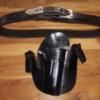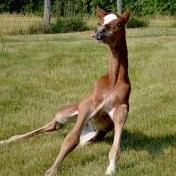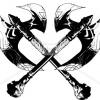All Activity
- Past hour
-
Hey, Dwight! I'm your Huckleberry! I've been sewing patches for bikers for a decade now. I use a patcher, a flat bed and a post machine depending on how the sewing needs to be done. Here's the breakdown. If the patch is on the back, or upper fronts, and there is no pocket or zip open liner behind it, I use a long bed flat bed Singer 139. It doesn't have reverse, but I sew all the way around the patches. No reverse is needed as the starting stitches are covered by at least 6 to 8 going over them. If the vest (cut) or jacket has a pocket to deal with, I use my Adler 30-7 long arm, big bobbin, high lift patcher. It easily gets into pockets and zip open linings. If the sewing is around the vicinity of the arm holes, I tend to use a post machine. It's much easier to turn the vest around the post with the excess hanging down that to fight with a flat bed or patcher. An example of when I use the post machine is when I'm sewing flags or club names, or office positions onto the upper shoulder, in the narrow area between the front and back seams. I use double-sided leather tape from Wawak to hold the patches in place for sewing. If the back is extra flimsy, or is made of denim, I also use a long body office stapler to keep the patch and material lined up. Next, I prefer to use #69 bonded thread with a #18 needle, unless it is on a jacket or padded vest. Then I'll use #92 with a #19 needle. As for the needles, I have learned to use round point needles when sewing any patch that has a serged or embroidered edge. This is because a leather point needle will slice the closely sewn edge thread whereas the round point just goes between them. The leather under the patch doesn't care about the needle. It is garment leather. If your machine takes a needle system that is available in titanium coated needles, buy those whenever possible. This really comes in handy if you are sewing through double-sided tape. I also keep a little can of Goof Off and a dauber near my machines so I can clear any glue or tape residue off the needle. If your patcher has a lube pot, fill it with clear liquid silicon to keep the top thread from sticking to the eye of the needle. While at Wawak, buy some steel thread snips. Put magnets on the body of your machines and let them hold the snips and threaders, bobbins, etc. Wind extra bobbins in advance so you don't have a lot of downtime when you run out of bobbin thread. Prewounds go a long way if they are available for your machine(s). That's all I've got to say about tha-at!
-
spring flowers and good food
Handstitched replied to chuck123wapati's topic in All About Us and Off Topic
If my memory serves, years ago , mum had a few tubs of clay in one of our sheds, 2 different types for different applications. They were hermetically sealed , and still soft ready to use, heat and moisture kept them preserved. I might try to find them . I wonder ? 🤔 I also have her potters wheel, tools etc. Had our last visit to the hospital this arvo (hopefully) just another video conference to go. All that I've been doing seems to have paid off , according to the nurse, can't thank them enough for their help. And yes, not a period to be repeated. Take care HS -
Those look great! I bought me some of those clips a couple years back but have never used them. I noticed you used screws to secure them. Are the holes in the leather just punched for the screws? Stabilized in any way? Great job again!!!
-
Everything I read about digital servos says they have high torque from a standstill. My digital servos with 200 rpm minimum speed start with lots of torque. It would be educational to have a digital servo that was fully programmable so we could try some experiments at very low speed. The control box on my "stitchman" digital servo has what looks like a 9-pin serial cable, but I have not checked to see if it's actually sending serial (UART) data across the line.
- Today
-
I have no experience with hand stitching, but a possible weakness with a saddle stitch might be that you keep pulling the same thread through the leather, abrading the thread and making it slightly weaker with each hole you pass. By the time you reach the fiftieth hole, the thread has been pulled through fifty holes. With a (machine) lockstitch only a short amount of (top) thread gets pushed through the hole and pulled back, while the bottom thread doesn't get pulled through at all. So any bit of the top thread at any moment in time has been pushed through the leather only a couple of times and so has only worn down a little bit. Increased thread abrasion with manual stitching is offset by typically using thicker thread sizes as far as I can tell (so they there is more material to abrade before the thread becomes too weak) and waxing the threads for lubrication (so they abrade less when pulled through holes). On the other hand, the threads in a lockstitch basically make a 180 degree U-turn and as has been said before, that sort of a concentrated pulling point might be a weak spot. That said, now I wonder where a thread usually breaks when it does: in the exposed bit along the leather (in which case it doesn't really matter which stitch type you use), or in the hidden bit inside the leather where the threads are either locked (lockstitch) or where they pass each other (saddle stitch). Also, to be fair, one should compare apples with apples: so we should compare different stitch types using the same thread type/size and leather and that could be hard. Running a thick waxed thread through a machine would require a heavy duting sewing machine and using an unwaxed machine thread while hand stitching for any serious length would probably wear away the fibres in the thread... In the end I think both stitch types are comparable in strength and it would largely depend on thread thickness, thread material, and the way in which an item is used how soon a stitch would fail.
-
Stitch strength heresy - Lock vs Saddle
Cumberland Highpower replied to AlZilla's topic in Sewing Leather
Saddle stitching mostly still exists for either of 2 reasons: 1) Novelty 2) Poverty. Novelty as in Hermes or other high end makers that are selling the work of skilled artisans and a high end/luxury item. Poverty as in you can't afford a stitcher, yet. Even when I hand stitch that rare item I don't use a saddle stitch anymore. (I use a speedy stitcher). the stitches look about the same and the strength is close enough. (Your hands are only going to last so long, don't wear them out fiddling with stitches). There are a very few times when saddle stitches are used by an equipped shop. Repair, someone just wants it done a certain way or reproduction of goods designed before machine stitching. -
Just to sew them on shirts . . . jackets . . . vests . . . etc. May God bless, Dwight
-
The machine has been listed on the estate auction.
-
Tall Post Sewing Machines?
Cumberland Highpower replied to Cumberland Highpower's topic in Leather Sewing Machines
RockyAussie thanks for the reply. How do you find the overall ergonomics? Are these high posts comfortable machines to operate sitting down or do you feel your knees crowded and having to reach excessively upwards to work? Probably not as bad as I'm visualizing sitting here, but wanted to ask. Makes sense about the post offset. -
Leatherworking is a great winter hobby—quiet, creative, and very satisfying. You can definitely do it all by hand, no machines needed. People have made stunning leather goods by hand for centuries, so you're good to go with just basic tools and patience. I recommend "The Art of Hand Sewing Leather" by Al Stohlman (great for stitching techniques) and "Leatherworking Handbook" by Valerie Michael for a broader overview of tools, types of leather, and project ideas. Starter Tool Kit (for your projects): Knife: A skiving knife and a utility knife (like L’indispensable) will cover most tasks. Pricking irons (3.0–3.85mm) – better than chisels for finer work. Stitching awl and needles (John James) + waxed linen thread. Edge beveler (#2 or #3), edge creaser, adjustable groover, scratch awl – all very useful. Don’t forget a cutting mat, ruler, and burnisher (wood or bone). Look into European suppliers like Decocuir (France) or Le Prevo (UK) for quality tools without crazy shipping costs. And yeah, it’s true—finding a job nowadays can be tough in most fields unless you're using special services or platforms to boost your chances. So having a productive hobby like leatherwork is a solid idea!
-
This is the reality, and i agree completely. The sewing machine is one of the greatest inventions man has ever made IMO and the lock stitch has worked for a long time too.
-
That's just it a saddle stitch doesnt create a knot while a lockstitch is basicly a series of knots. Visualize your threads. Saddle stitching is basically using two threads spiraling them together with leather in between with no tension built by the threads pulling against each ohter. while lockstitch is two pieces of thread wrapped around each other in every hole, pulling against each the oposing thread on the other side of the leather
-
That's an interesting point, Chuck. It seems the ability to use a sewing awl is a dying art, driven in part by the ability to market expensive punches and irons. I've been an advocate for the efficiency, versatility and esthetics of awl sewing - holes always line up, can sew odd shapes that are difficult to punch, the hole size matches the thread. I'll add strength of the stitch to the list. Strength is tested on a regular basis with horse tack. I haven't seen many examples of failed stitching. It's usually the leather breaking where it wraps around hardware. I have seen linen thread rotted out after many years.
-
Man, those look sharp. Did you use Tokonole finish on the outside?
-
take one piece of thread and try and break it then, take two pieces of the same thread and try and break them. I will add saddle stitching into drilled round holes defeats the thread's ability to lock together, the leather slit and the tension it provides is part of the process that makes saddle stitching a stronger and better choice IMO.
-
Not really unless you dump the clutch like in a standard transmission truck. kgg
-
😄New word learnt. Couldn't pass up the opportunity to use it!
-
I'm still new to leatherworking. I have made about a dozen holsters, a few knife scabbards, and quite a few belts. I currently have a flatbed sewing machine, a Seiko CW8 Cylinder Arm Machine, and Weaver Cub, and hoping to acquire a Class 4 machine when practical. My question is regarding the Landis 5 in 1. Are these machines particularly useful in the realm of holster and scabbard building? A friend of mine is a retired boot repair shop owner and once told me how much he used the presser wheel which was good when gluing layered edges and I can see that in the boot resoling application but would that part of the 5 in 1 have any benefit with holsters and scabbards? I can see where the cutting wheel could make cleaner edges before beveling and finishing. 500 to 700 is a pretty substantial investment for me and I don't mind IF it's something I will use frequently. Thanks in advance.
-
Ashley’s Book of Knots contains brief instructions on how to tie this. See plates 1705 and 1706 on page 294. (For some reason, I could not paste a link, but search Ashley’s Book of Knots PDF for a free online copy.) I first saw this knot back in the 1970s when a leather worker named Rob McCall (one of the most creative, inspired & inspiring leatherworkers I’ve met) used it to attach the buckle to his belts and simultaneously form a triple keeper. He also used it as an adjuster on his handbag straps. If you see a leather piece signed Sparrow, it’s one of his.
-
I really love the old Harleys, Would love to have an old 1947 Knuckle Head. I told my good friends this old 1951 Landis 16 is my Knuckle Head lol.
-
Yes it did on the larger leather pieces it works out nice. The tote bags I use a 5 to 6oz and the leather that is soft or milled and this helps out. Its a game changer with this machine..
-
I might have some spare screws. Based in Germany. Actually your 105 has been rebuild to a 105-6 standart to work with a roller feet, does the presser feet rod have a flat and bolt hole? I might have also some feet.
-
Margorie joined the community
-
I had look yon up










